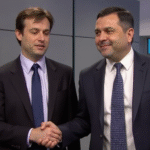Background on Key Figures and Relevance
Claudia Sheinbaum, the President of Mexico City, played a pivotal role in recent negotiations with the United States to avoid tariff hikes on Mexican exports. Her diplomatic skills and firm stance were instrumental in securing a 90-day extension of the current trade arrangement without any additional concessions from Mexico.
Negotiation Details and Agreement
Following weeks of negotiations, including a 40-minute phone call with U.S. President Donald Trump, Sheinbaum announced that both countries agreed to maintain the current trade terms for an additional 90 days. This pause allows time to work towards a long-term agreement, safeguarding the USMCA (United States-Mexico-Canada Agreement) which accounts for 84.4% of Mexico’s trade with the U.S.
Key Points of the Agreement
- No additional concessions were made by Mexico.
- The agreement prevents the planned tariff increases set to take effect on August 1.
- Negotiations will cover both tariff and non-tariff issues.
Reactions and Implications
Mexico’s Secretary of Economy, Marcelo Ebrard, praised Sheinbaum’s negotiation skills and highlighted the significant impact of the agreement. He emphasized that Mexico’s trade deal with the U.S. is more advantageous than any other country’s, except Canada.
Ebrard also mentioned sensitive topics under discussion, such as extending patent terms for U.S. pharmaceutical labs, which could affect Mexico’s healthcare system by limiting local production.
Mexico’s Trade Agreements with Other Nations
In parallel, Donald Trump has been negotiating trade agreements with other countries:
- United Kingdom: A base tariff of 10% and zero-tariff export quota for vehicles.
- Vietnam: An access tariff of 20% and a 40% tariff on triangular products.
- Philippines and Indonesia: A 19% access tariff to U.S. markets.
- Japan: A base tariff rate of 15% and a $550 billion investment fund for U.S. investments.
- European Union: A base tariff rate of 15% and a $6 billion investment commitment from European companies in the U.S.
- South Korea: Despite an existing FTA, South Korea agreed to a 15% tariff on exports and a $100 billion energy product purchase commitment, along with a pledge to invest $350 billion in the U.S.
Key Questions and Answers
- What was the purpose of the negotiations? To avoid tariff increases on Mexican exports to the U.S. and work towards a long-term trade agreement.
- Who were the key figures in the negotiations? Mexico’s President Claudia Sheinbaum and U.S. President Donald Trump.
- What did Mexico agree to? Mexico agreed to maintain the current tariff-free terms for 90 days, focusing on autos (with discounts), steel, aluminum, and copper products.
- What sensitive topics are being discussed? Pharmaceutical patent extensions that could impact Mexico’s healthcare system by limiting local production.






